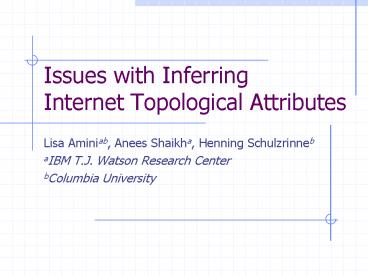Issues with Inferring Internet Topological Attributes - PowerPoint PPT Presentation
1 / 14
Title:
Issues with Inferring Internet Topological Attributes
Description:
No single entity has complete representation ... Looking Glass. HTTP interface. Traceroute to target address. BGP route entry (AS_PATH) ... – PowerPoint PPT presentation
Number of Views:47
Avg rating:3.0/5.0
Title: Issues with Inferring Internet Topological Attributes
1
Issues with Inferring Internet Topological
Attributes
- Lisa Aminiab, Anees Shaikha, Henning Schulzrinneb
- aIBM T.J. Watson Research Center
- bColumbia University
2
Internet Mapping
- Goal
- Create mathematical and graph theoretic models of
the Internet - detect pathologies
- improve existing protocols
- validate proposals for new protocols
- predict the future evolution of the Internet
- Issues
- Rapid growth
- No single entity has complete representation
- Conflicting empirical data (routing tables,
traceroute) - Can the impact of these ambiguities be
quantified?
3
BGP Routing Tables
Transit Networks
Stub Networks
Autonomous Systems (AS)
- IP network address advertisements include
AS_PATH - Partial Information
- Single Viewpoint, Route Selection, Route
Filtering - Intra- vs Inter- domain
- Static Routes, Source Routing, Multihop BGP
Sessions
4
traceroute
- Set TTL to elicit ICMP response from
intermediate routers - Associate router IP address with AS number
- AS Number Resolution
- Registry Data, Multiple AS Numbers
- ICMP Message Generation
5
Data Sources
- Looking Glass
- HTTP interface
- Traceroute to target address
- BGP route entry (AS_PATH)
- Geographically and topologically diverse
- 92 with BGP and traceroute enabled
- www.antc.uoregon.edu/route-views
- Oregon Route Views
- BGP routing tables
- Peers with 57 other routers
- Most major ISPs represented
- www.traceroute.org
6
Methodology
- D1 Randomly pair LGs to collect forward and
reverse paths of each type at Poisson intervals - 116302 attempted measurements
- 8464 unique routes (2840 fully paired)
- 337 ASs (100 of top 20 ASs in D2, ranked by
degree) - D2 Oregon Route Views tables for 18 days
corresponding with D1. - 13054 ASs
- D3 Randomly pair LG with advertised network
address at Poisson intervals. - 62645 measurements (27185 unique routes)
- D4 Oregon Route Views tables for 11 days
corresponding with D3.
7
AS Path Asymmetry
A
B
- Path(A,B) g Path(B,A)
- 1995 (Paxson) study found AS path asymmetry at
30 - Current (1Q2002) level 69.8
- Artificially inflated?
- BGP-assisted resolution 61.4
- BGP AS_PATH asymmetry 56.3.
8
Distribution of Hop Differences
Nearly 15 difference between traceroute and
AS_Path results
of Routes
Of the routes that were asymmetric, nearly 60-80
differed by only one or two hops.
AS Hop differences
9
BGP Prediction of Traceroute Path
Mean Path Length traceroute 4.49 hops BGP
AS_PATH 4.15 hops
32.7 of routes differed in path length
Number of Routes
ICMP message generation and routing policy can
inflate traceroute path
Multi-hop BGP sessions can make traceroute paths
appear inflated
AS Path Length
10
BGP Prediction of Traceroute Path
Comparison of AS hops not represented in
corresponding traceroute/BGP path (if different)
Neither BGP nor traceroute paths strictly
longer/shorter 74 of differing length routes
traceroute path had a single additional node not
in BGP AS_PATH
Number of Routes
Number of AS Hops Not Represented
11
AS Degree
- Internets AS topology be represented with purely
mathematical formulation? - Hierarchical connectivity and routing policies
must be represented - Hierarchical representation (AS degree) conforms
to power laws - Analysis based on D3, D4 datasets
- Nodes/edges discovered in traceroute paths
- Nodes/edges discovered in BGP AS_PATHs
- Nodes/edges discovered in Oregon Route View BGP
table
12
BGP AS_PATH
traceroute
AS Degree (in log10)
Rank (log10)
All
Oregon router
13
AS Degree Comparison
traceroute and BGP AS_PATH data almost completely
overlapped traceroute included only 18
additional nodes BGP had 200 edges not in
traceroute visual inspection traceroute had 1
addl node XP. Of 3700 BGP, traceroute nodes
only 35 not in Oregon
AS Degree
AS Rank
14
What can we conclude?
- Advertised portion of routing policy and the
packet forwarding behavior can differ
significantly - Minimal differences in attributes representing
aggregates - mean path length
- AS degree distribution
- Current data sources not completely reliable for
per path attributes - forward/reverse traceroute
- BGP prediction of traceroute































